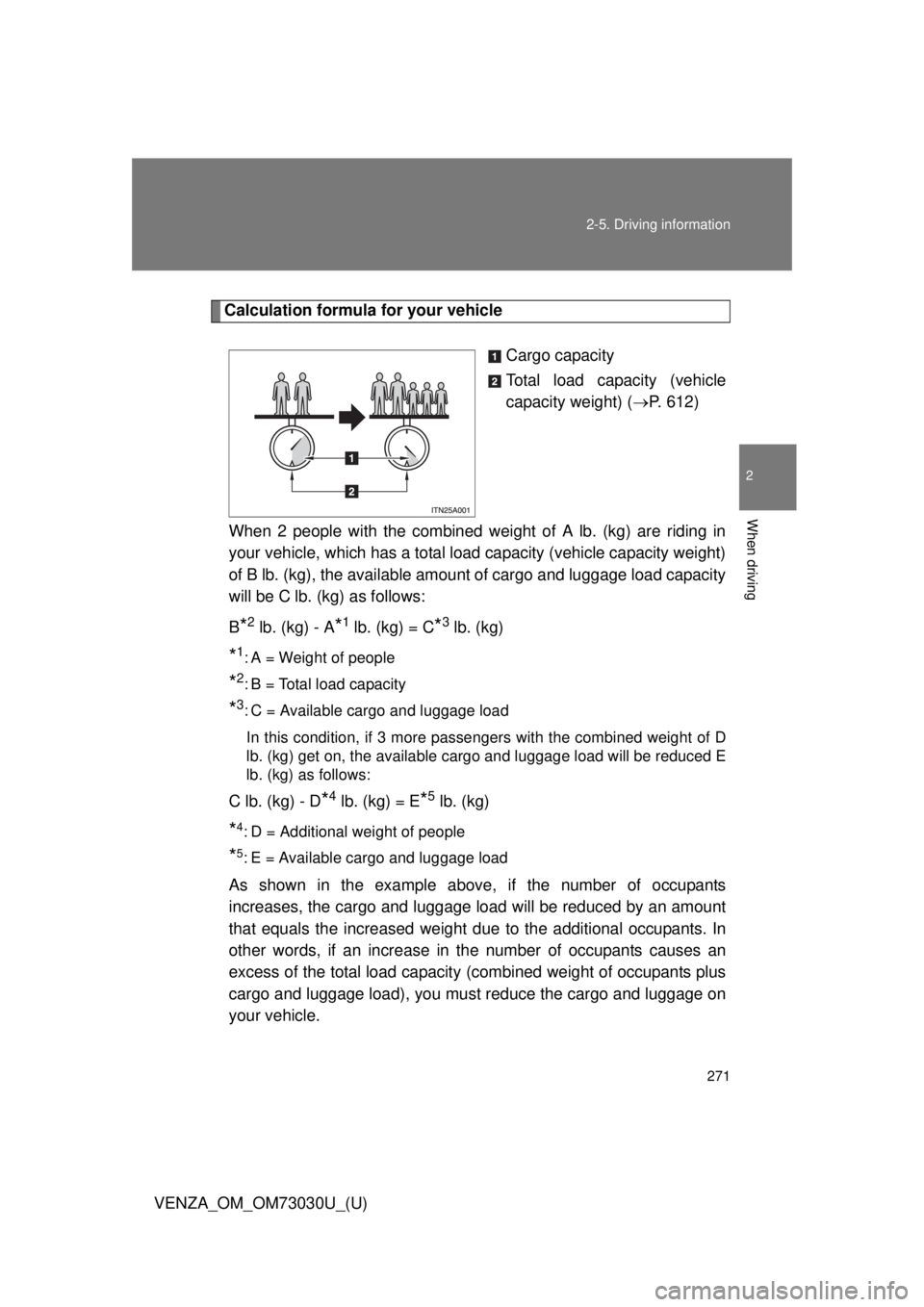Page 261 of 688

2612-4. Using other driving systems
2
When driving
VENZA_OM_OM73030U_(U) CAUTION■ When TRAC and VSC are off
Be especially careful and drive at a speed appropriate to the road condi-
tions. As there are systems to help ensure vehicle stability and driving force,
do not turn off TRAC and VSC unless necessary.
■ When the VSC is activated
The slip indicator light flashes. Always drive carefully.
Reckless driving may cause an accident. Exercise particular care when the
indicator light flashes.
■ Replacing tires
Make sure that all tires are of the same size, brand, tread pattern and total
load capacity. In addition, make sure that the tires are inflated to the speci-
fied tire pressure level.
The ABS and VSC will not function correctly if different tires are fitted on the
vehicle.
Contact your Toyota dealer for further information when replacing tires or
wheels.
■ Handling of tires and suspension
Using tires with any kind of problem or modifying the suspension will affect
the driving assist systems, and may cause the system to malfunction.
■ Active Torque Control 4WD system
● The AWD system of this vehicle is intended to ensure driving stability on
normal roads. It is not designed for use in demanding situations such as
rally driving.
● Take care when driving on slippery road surfaces.
Page 269 of 688
2692-5. Driving information
2
When driving
VENZA_OM_OM73030U_(U) Cargo and luggage Take notice of the following information about storage precau-
tions, cargo capacity and load.
● Stow cargo and luggage in the luggage compartment when-
ever possible. Be sure all items are secured in place.
● Be careful to keep the vehicle le vel. Placing the weight as far
forward as possible helps maintain vehicle balance.
● For better fuel economy, do no t carry unnecessary weight.
Page 270 of 688

2702-5. Driving information
VENZA_OM_OM73030U_(U) Capacity and distribution
Cargo capacity depends on the total weight of the occupants.
(Cargo capacity) = (Total load capa city) — (Total weight of occupants)
Steps for Determining Correct Load Limit—
(1) Locate the statement “The co mbined weight of occupants and
cargo should never exceed XXX kg or XXX lbs.” on your vehi-
cle’s placard.
(2) Determine the combined weight of the driver and passengers
that will be riding in your vehicle.
(3) Subtract the combined weight of the driver and passengers from
XXX kg or XXX lbs.
(4) The resulting figure equals the available amount of cargo and
luggage load capacity.
For example, if the “XXX” amount equals 1400 lbs. and there will
be five 150 lb passengers in your vehicle, the amount of avail-
able cargo and luggage load capacity is 650 lbs. (1400 - 750 (5
150) = 650 lbs.)
(5) Determine the combined weight of luggage and cargo being
loaded on the vehicle.
That weight may not safely ex ceed the available cargo and lug-
gage load capacity calculated in Step 4.
(6) If your vehicle will be towing a trailer, load from your trailer will
be transferred to your vehicle. Consult this manual to determine
how this reduces the available cargo and luggage load capacity
of your vehicle. ( P. 274)
Page 271 of 688

2712-5. Driving information
2
When driving
VENZA_OM_OM73030U_(U) Calculation formula for your vehicle
Cargo capacity
Total load capacity (vehicle
capacity weight) ( P. 612)
When 2 people with the combined weight of A lb. (kg) are riding in
your vehicle, which has a total load capacity (vehicle capacity weight)
of B lb. (kg), the available amount of cargo and luggage load capacity
will be C lb. (kg) as follows:
B
* 2
lb. (kg) - A
* 1
lb. (kg) = C
* 3
lb. (kg)
* 1
: A = Weight of people
* 2
: B = Total load capacity
* 3
: C = Available cargo and luggage load
In this condition, if 3 more passengers with the combined weight of D
lb. (kg) get on, the available carg o and luggage load will be reduced E
lb. (kg) as follows:
C lb. (kg) - D
* 4
lb. (kg) = E
* 5
lb. (kg)
* 4
: D = Additional weight of people
* 5
: E = Available cargo and luggage load
As shown in the example above , if the number of occupants
increases, the cargo and luggage load will be reduced by an amount
that equals the increased weight du e to the additional occupants. In
other words, if an increase in th e number of occupants causes an
excess of the total load capacity (combined weight of occupants plus
cargo and luggage load), you must reduce the cargo and luggage on
your vehicle.
Page 273 of 688
2732-5. Driving information
2
When driving
VENZA_OM_OM73030U_(U) CAUTION■
Weight of the load ●
Do not exceed the maximum axle weight rating or the total vehicle
weight rating.●
Even if the total load of occupant’s weight and the cargo load is less
than the total load capacity, do no t apply the load unevenly. Improper
loading may cause deterioration of st eering or braking control which
may cause death or serious injury.
Page 274 of 688
2742-5. Driving information
VENZA_OM_OM73030U_(U)Vehicle load limits Vehicle load limits include total load capacity, seating capacity,
Trailer Weight Rating (TWR) and cargo capacity.
■ Total load capacity (vehicle capacity weight): P. 612
Total load capacity means the combined weight of occupants,
cargo and luggage.
■ Seating capacity: 5 occupants (Front 2, Rear 3)
Seating capacity means the ma ximum number of occupants
whose estimated average weight is 150 lb. (68 kg) per person.
Even if the number of occupants is within the seating capacity,
do not exceed the total load capacity.
■ Trailer Weight Rating (TWR): P. 288, 612
Trailer Weight Rating (TWR) means the maximum gross trailer
weight (trailer weight plus its ca rgo weight) that your vehicle is
able to tow.
■ Cargo capacity
Cargo capacity may increase or decrease depending on the
weight and the number of occupants.
Page 275 of 688
2752-5. Driving information
2
When driving
VENZA_OM_OM73030U_(U) ■
Total load capacity and seating capacity
These details are also described on the tire and loading information
label. ( P. 513)
CAUTION■
Overloading the vehicle
Do not overload the vehicle.
It may not only cause damage to the ti res, but also degrade steering and
braking ability, resulting in an accident.
Page 299 of 688

2992-5. Driving information
2
When driving
VENZA_OM_OM73030U_(U) CAUTION■ Trailer towing precautions
To tow a trailer safely, use extreme care and drive the vehicle in accordance
with the trailer’s characteristics and operating conditions. Failure to do so
could cause an accident resulting in death or serious injury. Vehicle stability
and braking performance are affected by trailer stability, brake setting and
performance, and the hitch. Your vehicle will handle differently when towing
a trailer.
■ To avoid accident or injury
● Do not exceed the TWR, unbraked TWR, GCWR, GVWR or GAWR.
● Vehicles with a towing package: If the gross trailer weight is over 2000 lb.
(907 kg), a sway control device with sufficient capacity is required.
● Adjust the tongue weight within the appropriate range. Place heavier loads
as close to the trailer axle as possible.
● Do not exceed 65 mph (104 km/h), the posted towing speed limit or the
speed limit for your trailer as set forth in your trailer owner’s manual,
whichever is lowest. Slow down sufficiently before making a turn, in cross-
winds, on wet or slippery surface, etc. to help avoid an accident. If you
experience a vehicle-trailer instabilit y from reducing a certain speed, slow
down and make sure you keep your vehicle speed under the speed of
which you experience the instability.
● Do not make jerky, abrupt or sharp turns.
● Do not apply the brakes suddenly as you may skid, resulting in jackknifing
and loss of vehicle control. This is especially true on wet or slippery sur-
faces.
● Do not exceed the trailer hitch assembly weight, gross vehicle weight,
gross axle weight and trailer tongue weight capacities.